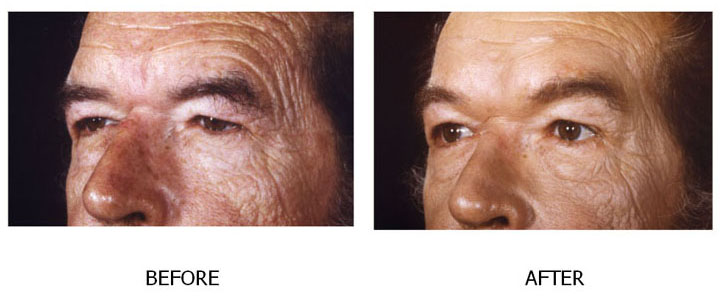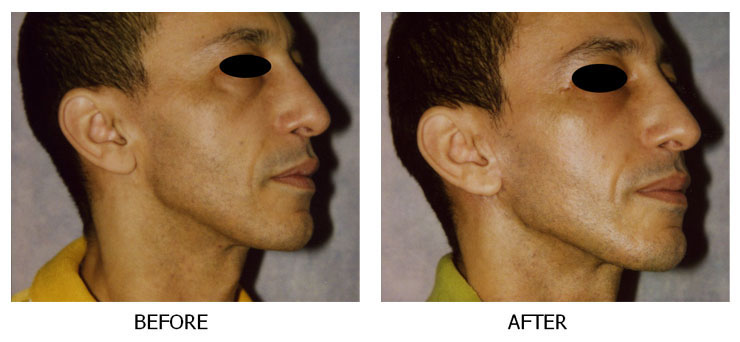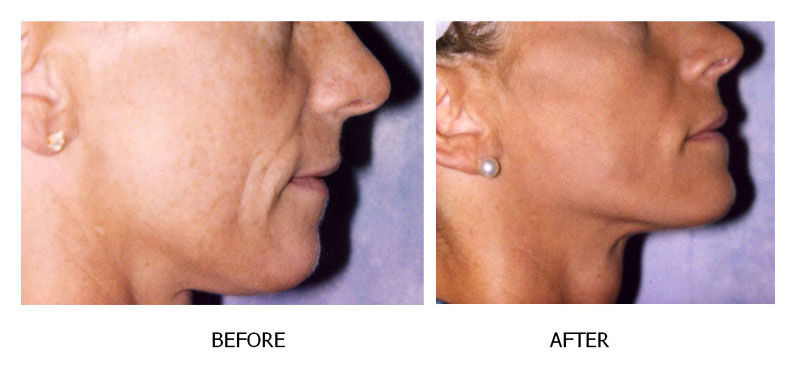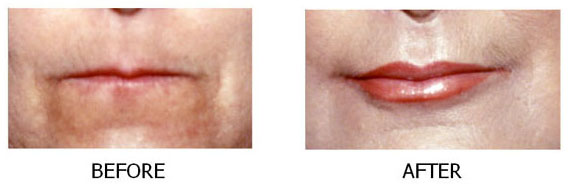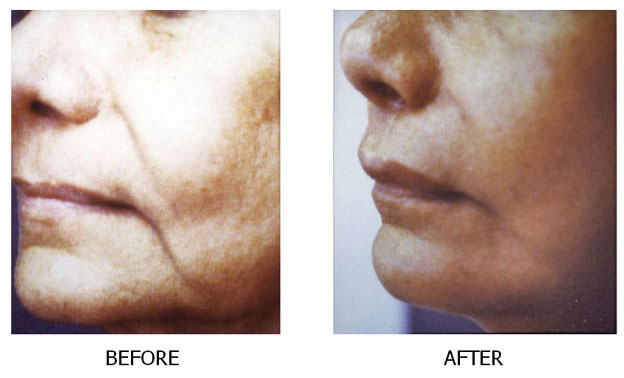Injectables
Improving Skin Texture
As we age, our faces begin to show the effects of gravity, sun exposure and years of facial muscle movement, such as smiling, chewing and squinting. The underlying tissues that keep our skin looking youthful and plumped up begin to break down, often leaving laugh lines, smile lines, crow's feet or facial creases over the areas where this muscle movement occurs.Soft-tissue fillers, most commonly injectable collagen or fat, can help fill in these lines and creases, temporarily restoring a smoother, more youthful-looking appearance. When injected beneath the skin, these fillers plump up creased and sunken areas of the face. They can also add fullness to the lips and cheeks. Injectable fillers may be used alone or in conjunction with a resurfacing procedure, such as a laser treatment, or a recontouring procedure, such as a facelift.
If you're considering a facial-rejuvenation treatment with collagen or fat, this page will give you a basic understanding of the procedure - when injectables can help, how the procedure is performed, and what results you can expect. It may not answer all of your questions, since a lot depends on your individual circumstances. Please ask your doctor if there is anything about the procedure you don't understand.
Knowing your options
Injected collagen and fat are primarily used to improve the appearance of the skin's texture. They can help fill out deep facial wrinkles, creases and furrows, "sunken" cheeks, skin depressions and some types of scars. They can also be used to add a fuller, more sensuous look to the lips.Injectables are usually not sufficient for severe surface wrinkles on the face, such as multiple vertical "lipstick lines" that sometimes form around the mouth. Instead, your plastic surgeon may suggest a resurfacing technique, such as chemical peel, dermabrasion or laser treatments. Rather than filling in facial lines, resurfacing methods strip away the outer layers of the skin to produce a smoother appearance.
Deep folds in the face or brow caused by overactive muscles or by loose skin may be more effectively treated with cosmetic surgery, such as a facelift or browlift. Injectables are sometimes used in conjunction with facial surgery procedures; however, injectables alone cannot change facial contour the way surgery can.
Keep in mind that a plastic surgeon is a specialist that can offer you the most advanced treatments ranging from cosmetic surgery, refinishing techniques, injectables and the use of other fillers. You and your surgeon may determine that a single procedure or a combination of procedures is the best choice for you.

Injectable collagen or fat can help
improve the skin's texture by filling
in the laugh lines and facial creases
that often occur with aging.
A word about other types of fillers
This page deals with the two most commonly used types of injectable fillers, collagen and fat. However, to a lesser extent, a number of other filler materials are also being used for facial-rejuvenation purposes. They include: Fibril, a gelatin powder compound that's mixed with a patient's own blood and is injected to plump up the skin (similar to injectable collagen); and Gortex, a thread-like material that is implanted beneath the skin to add soft-tissue support.Each of these options has its own set of risks and benefits. If you're considering any of these alternative filler treatments, tell your doctor.
What to expect from treatment
The most important fact to remember about injectable fillers is that the results are not permanent. Injected material is eventually metabolized by the body. You should not expect the same long-lasting results that may be gained from cosmetic surgery.In some individuals, the results may last only a few weeks; in others, the results may be maintained indefinitely. Researchers believe that age, genetic background, skin quality and lifestyle as well as the injected body site may all play a role in the injected material's "staying power." However, the precise reason for the variation of results among patients has yet to be identified.
If you've had short-lived results from fat injections, you shouldn't necessarily assume that collagen injections will work better for you. And, conversely, if you've had disappointing results from collagen, don't assume that injected fat is the answer. Although it's true that some individuals' bodies are more receptive to one substance than the other, others may find that neither substance produces long-lasting results. Sometimes one substance may work better than the other for a specific problem.
Risks related to injectables
When injectables are administered by a qualified plastic surgeon, complications are infrequent and usually minor in nature. Still, individuals vary greatly in their anatomy, their physical reactions and their healing abilities. The outcome of treatment with injectables is never completely predictable.Risks not necessarily related to allergies include infection, abscesses, open sores, skin peeling, scarring and lumpiness, which may persist over the treated area. Reports of these problems are very rare.
Fat: Allergic reaction is not a factor for fat because it's harvested from a patient's own body. However, there is still a small risk of infection and other infrequent complications.
Planning for treatment
Facial rejuvenation is very individualized. That's why it's important to discuss your hopes and expectations with a board-certified plastic surgeon who has experience with many different types of surgical and non-surgical facial procedures.In your initial consultation, your plastic surgeon will evaluate your face - the skin, the muscles and the underlying bone - and discuss your goals for the surgery. Your doctor will help you select a treatment option based on your goals and concerns, your anatomy and your lifestyle.
Your surgeon will ask you about your medical history, drug allergies, and check for conditions that could cause problems, such as active skin infections or non-healed sores from injuries. Collagen injections are generally off limits for pregnant women, individuals who are allergic to beef or bovine products, patients who suffer from autoimmune diseases, and those who are allergic to lidocaine (the anesthetic agent contained in the syringe with the collagen material). For more specific information about the contraindications and risks of collagen use, ask your doctor for the manufacturer's brochure for patients.
Insurance usually doesn't cover cosmetic procedures. However, if your injectable treatment is being performed to treat a scar or indentation from an accident or injury, you may be reimbursed for a portion of the cost. Check with your insurance carrier to be sure.
Where your treatment will be performed
Injectables are usually administered in a surgeon's office-based facility. If, however, you are being hospitalized for a facelift, necklift, browlift, or any other procedure, your injections may be administered in the hospital as well.
Types of anesthesia
Collagen: Because the anesthetic agent lidocaine is mixed in with collagen, additional anesthetic is usually not used. However, if you are especially sensitive to pain, your doctor may use a topical cream anesthetic or a freon spray to numb the injected area. Or, you may elect to have an injected local anesthetic or sedative drugs.Fat: Both the donor and recipient sites are numbed with local anesthesia. Sedation can be used as well. If you elect to use sedation, be sure to arrange for a ride home after your treatment.
The Treatments
Collagen is a naturally occurring protein that provides support to various parts of the human body: the skin, the joints, the bones and the ligaments. Injectable collagen, patented by the Collagen Corporation under the trade names Zyderm and Zyplast, is derived from purified bovine collagen. The purification process creates a product similar to human collagen. Injectable collagen received approval from the Food and Drug Administration in1981. It is produced in various thicknesses to meet individual patient needs.Collagen is used primarily to fill wrinkles, lines and scars on the face and sometimes the neck, back and chest.
The procedure: Treatment with collagen can begin after a skin test determines that you're not allergic to the subsstance. The collagen is injected using a fine needle inserted at several points along the edge of the treatment site. If a local anesthesia has not been used, you may feel some minor stinging or burning as the injections are administered.
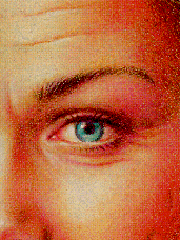
Years of squinting and other facial
muscle movements can take their toll
on the eye area, leaving crow's feet
and other noticeable lines
Since part of the substance is salt water that will be absorbed by the body within a few days, your doctor will slightly overfill the area. You may be asked to hold a hand mirror during the procedure to help your doctor decide when you've had enough.
After treatment: Immediately following treatment, you may notice some minor discomfort, stinging or throbbing in the injected area. Occasionally some bruising or swelling will occur, but it is usually minor. Any redness that appears in the injected site usually disappears within 24 hours. However, in some individuals, particularly fair-skinned patients, this redness may persist for a week or more. Tiny scabs may also form over the needle-stick areas; these generally heal quickly.
No bandaging is needed and you are free to eat, drink, and wear makeup with sunblock protection shortly thereafter. There may be some temporary swelling and redness in the treated area which should dissipate within a few days. If these symptoms persist, contact your surgeon.
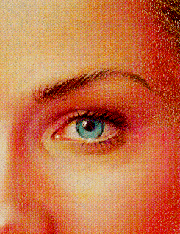
After treatment, the skin around the eye
area appears smoother and more taut.
Results: As stated earlier, the duration of results from collagen
injections is variable. Collagen's longevity depends on the patient's lifestyle
and physical characteristics as well as the part of the body treated. In
general, the injected material is likely to disappear faster in areas that
are more affected by muscle movement.Your doctor can help you determine how long you can go between treatments to best maintain your results.
Fat
In the medical world, the fat-injection procedure is known as autologous fat transplantation or microlipoinjection. It involves extracting fat cells from the patient's abdomen, thighs, buttocks or elsewhere and reinjecting them beneath the facial skin. Fat is most often used to fill in "sunken" cheeks or laugh lines between the nose and mouth, to correct skin depressions or indentations, to minimize forehead wrinkles and to enhance the lips.The procedure: After both the donor and recipient sites are cleansed and treated with a local anesthesia, the fat is withdrawn using a syringe with a large-bore needle or a cannula (the same instrument used in liposuction) attached to a suction device. The fat is then prepared and injected into the recipient site with a needle. Sometimes an adhesive bandage is applied over the injection site.

Lines and creases that form around the
mouth are usually caused by gravity
and a breakdown of tissues beneath
the skin.
As with collagen, "overfilling" is necessary to allow for fat absorption in the weeks following treatment. When fat is used to fill sunken cheeks or to correct areas on the face other than lines, this overcorrection of newly injected fat may temporarily make the face appear abnormally puffed out or swollen.
After treatment: If a larger area was treated, you may be advised to curtail your activity for a brief time. However, many patients are able to resume normal activity immediately. You can expect some swelling, bruising or redness in both the donor and recipient sites. The severity of these symptoms depends upon the size and location of the treated area. You should stay out of the sun until the redness and bruising subsides - usually about 48 hours. In the meantime, you may use makeup with sunblock protection to help conceal your condition.
The swelling and puffiness in the recipient site may last several weeks, especially if a large area was filled.

The lower face appears firmer and
smoother after treatment with injectables.
Lines around the mouth are filled in and
nearly imperceptible.
Results: The duration of the fat injections varies significantly from patient to patient. Though some patients have reported results lasting a year or more, the majority of patients find that at least half of the injected fullness disappears within 3-6 months. Therefore, repeated injections may be necessary. Your doctor will advise you on how to maintain your results with repeat treatments.
Your new look
If you're like most patients, you'll be very satisfied with the results of your injectable treatments. You may be surprised at the pleasing results that can be gained from this procedure.

